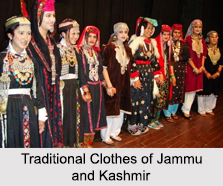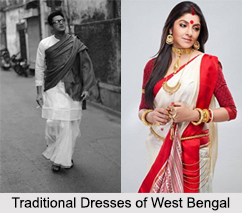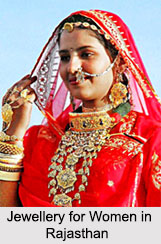 Jewellery for Women in Rajasthan plays a vital role in lifestyle of the People of Rajasthan. The Rajasthani jewelleries are a part of the daily ornamentation and a mark to describe their present status as well. Rajasthani women adorn themselves starting from their forehead up to the toe. The ornaments of Rajasthani women portray the culture and tradition of the region. They are beautiful and gorgeous in outlook with religious and customary significance.
Jewellery for Women in Rajasthan plays a vital role in lifestyle of the People of Rajasthan. The Rajasthani jewelleries are a part of the daily ornamentation and a mark to describe their present status as well. Rajasthani women adorn themselves starting from their forehead up to the toe. The ornaments of Rajasthani women portray the culture and tradition of the region. They are beautiful and gorgeous in outlook with religious and customary significance.
Head Jewellery for Women in Rajasthan
Rajasthan has a long tradition of ornaments for the forehead. The various types of Head Jewellery for Women in Rajasthan are as follows:
1. Bor: The Bor is usually placed right in the middle of the forehead. The Bor is an essential symbol of marriage and is worn only after the wedding rituals are completed. It is presented to the bride by her husband"s family and is worn everyday for as long as she remains a married woman.
2. Sir-Maang: Sir-Maang is worn only in the parting of the hair. The structure of this ornament is usually a single chain set with precious stones.
3. Seldi: The Seldi is worn at the end of a braid and is a popular hair ornament made of gold or silver and has a conical shape, with tiny bells dangling from its base.
4. Shishphul: The Shishphul literally means a head flower. This ornament is usually made of gold and has three flat floral pendants joined by chains, with smaller pendants in the centre.
5. Tika: A Tika can be a circular or heart shaped pendant with a small chain affixed at the back that has a clasp on its end, which hooks it to the hair.
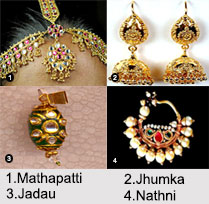 Ear Jewellery for Women in Rajasthan
Ear Jewellery for Women in Rajasthan
Ear ornaments of the Rajasthani women are a charming enhancement to their appearance. The most popular earring is in the shape of a five-petalled flower, set with pearls and precious stones. The various types of Ear Jewellery for Women in Rajasthan are as follows:
1. Bedla: The Bedla is either circular in shape or long and is worn on the upper region of the ear. Two or three are worn together by married women. Bedla are small curved wires, with heart shaped ends.
2. Jhumka: The Jhumka, Jhumar or Jhumri are among the most popular ear ornaments in Rajasthan. They are bell-shaped earrings, made in gold or silver. Rajput and Mahajan women adorn themselves with gold Jhumka.
3 Karnphul: The Karnphul are shaped like a five-petalled flower. They are often embedded with precious and semi-precious stones.
4. Kudka: The kudka is created from brass and worn mainly by Meghvai and Sindhi Muslim women. This earring has two particular semi-spherical parts of different sizes that are linked. The centre of each piece is often set with a stone.
5. Kundal: Kundal are large circlets, set with valuable stones on their noticeable surface and usually enamelled on the reverse side. These are different ear ornaments and are worn mostly by Muslim women in Rajasthan.
6. Nasbi: The central fold of the ear is known as the nasbi and the ornament worn on this part is named after it. This is a small gold ring worn in the centre of one ear. It is put on during marriage and never removed. A popular belief among the people here is that those who wear this ornament secure a place for themselves in heaven.
Nose Jewellery for Women in Rajasthan
Nose Jewellery is the most symbolic and visible ornament to identify how a community decorates the nose. It is worn by a woman at the time of her wedding and is a symbol of her marital status. It is associated with a woman"s honour and "nathni utarna", meaning removing a nose ring indicates her disgrace. The nose ring, worn most commonly in Rajasthan represents the sun and the moon. The large circle represents the sun and under the nose is the hemispherical moon. The upper portion is studded with red stones and the under portion has white ones.
Neck Jewellery for Women in Rajasthan
The neck is often the most heavily ornamented area of a woman"s body. Even within the same community, neck jewellery may reveal an enormous variety. Some of them are as follows:
1. Badla: Badla is a circular, cylindrical, hollow, round circlet piece, which tapers towards at one end. It is generally made in silver, except in certain communities like the Rajput, who use a gold version of the ornament. Only Hindu women wear the Badla after marriage.
2. Galapatti: The Galapatti or Gulaband, is an ornament, literally a `neckband`, made by stringing together small pieces of kundan or Meenakari to form a necklace. The necklace, when worn, covers the neck like a collar.
3. Haar: Haar is a standard term for any long necklace and could also suggest a garland. These necklaces may be of varying lengths, demonstrating tremendous variety of styles and forms. Patri Haar, Ath Pahlu Haar, Lam Haar and Chandan Haar are some of the types of Haar in Rajasthan.
4. Hansli: The ornament Hansli derives its name from the word ham which means `neck`. The whole ornament is made of forged silver and some additional linear designs and sometimes designs are also engraved on its surface.
5. Kanthi: The kanthi is worn close to the throat or kanth. Small gold or silver units are threaded together with rows of black beads. The center piece is a half moon, flanked by two floral units, which are, in turn, adjoined by rectangular pieces.
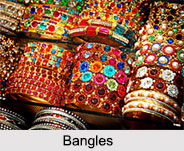 Hand Jewellery for Women in Rajasthan
Hand Jewellery for Women in Rajasthan
Hand Jewellery plays such a vital role in the Rajasthani woman"s life. The short-sleeved "Kanchli" is possibly designed to highlight the wearer"s complicated bangles, which start at the upper arm and move all the way down to the wrists, covering the bare arm. The "Bajubandh" in gold or silver is worn on the upper arm, just above the elbow.
All married Hindu women wear the "Chuda" in Rajasthan. A woman puts on the Chuda at the time of her marriage, offering prayers for her husband"s safety from calamities and the preservation of her marital status. A "Kanganpola" is a circular hollow ring worn above the elbow by the women of the Sindhi Musalman community. "Katariya" bangle is worn below the Chuda and "Mangli" is worn above the elbow. "Bahiyan" is a type of bangle that is worn by most Bhil women.
Finger Jewellery for Women in Rajasthan
A variety of accessories ornaments the fingers of Rajasthani women. The "Arsi" is a silver thumb ring, which is worn in other parts of the country, as well. "Hathphul" covers the back of the hand and although it has several variations, its commonest form has an ornamented spherical plate at its centre.
Hip Jewellery for Women in Rajasthan
The exquisite ornaments that grace the waistline enhance the wearer"s charm. "Kanakti", "Kamarbandh" or "Kandora" is a heavy girdle worn around the waist by almost all women in Rajasthan.
Feet Jewellery for Women in Rajasthan
The ankles and feet, like all other parts of the body are broadly decorated. A large variety of rings, usually known as "Angushlha" are worn on the feet. The "Avla" is a hollow, evenly circular ring. "Bichiya" is symbolic of the woman`s marital status. "Hirmani" is a single solid wire worn on one foot. When three leg ornaments, the "kada", "nang" and "payal", are worn as a set, they are known as a "Jod". "Rimjhol" is an evenly formed ring and is an ornament, which tinkles with foot movement.
